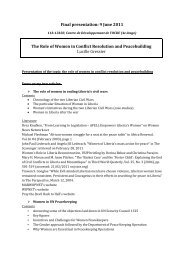Women's Economic Opportunity Index - Economist Intelligence Unit
Women's Economic Opportunity Index - Economist Intelligence Unit
Women's Economic Opportunity Index - Economist Intelligence Unit
- No tags were found...
Create successful ePaper yourself
Turn your PDF publications into a flip-book with our unique Google optimized e-Paper software.
Appendix IWomen’s economic opportunityA new global index and rankingFor an entrepreneur, access to credit can be key to starting or growing a business. A study in 2007found that banks are more likely to extend loans in countries that have strong collateral laws and wherecredit registries exist. 55 This study looked at credit institutions across 129 countries over 25 years. Overall,both strengthened legal creditor rights and more effective sharing of credit information are associatedwith higher ratios of private credit to GDP. 56Most credit registries record historical credit information on individuals’ or companies’ bank loans, anda growing number also record credit from utilities and retailers. This may be especially important for newwomen business owners who may not have a credit history of existing business or property loans. Furtherresearch suggests that establishing strong legal rights and new credit registries may also reduce incomeinequality. 57 As women in most countries have lower incomes than men, this suggests again that womenmay benefit disproportionately from better credit information.A forthcoming paper on credit and women-owned businesses tests the hypothesis of whether creditreporting improves access to finance for women-owned businesses. 58 The two appear to be directlyrelated. In addition, the paper finds that women tend to have superior payment performance to men,especially when they are credit rationed and underrepresented in the loan market. Therefore, reportingthis type of information would give them a positive edge in applying for credit and would help women togain increased access to finance.55. S Djankov, C McLiesh and AShleifer, “Private Credit in 129Countries”, Journal of Financial<strong>Economic</strong>s, Vol. 84, No. 2, 2007,pages 299-329.56. ibid.57. S Claessens, and E Perotti,“Finance and Inequality:Channels and Evidence”, Journalof Comparative <strong>Economic</strong>s, Vol.35, No. 4, 2007, pages 748-773.58. M Miller, Credit reportingand women-owned businesses(working title), papercommissioned by the World BankGroup’s Gender Action Plan,forthcoming.59. Consultative Group to Assistthe Poor, “Financial Access 2009:Measuring Financial InclusionAround the World”, World Bank:Washington DC, 2009.60. Banking the Poor: MeasuringBanking Access in 54 Economies,World Bank: Washington DC,2008.Further ReadingS Coleman, “Constraints faced by women small business owners: evidence from the data”, Journal ofDevelopmental entrepreneurship, Vol. 7, No. 2 (August), 2002, pages 151-174.D Karlan and J Zinman, “Expanding Credit Access: Improving Microfinance Operations and MeasuringImpact with Credit Scoring”, 2007, Basis Briefs, November 2009, Department of Agricultural and Applied<strong>Economic</strong>s, University of Wisconsin: Madison.Financial Services ProvisionThis indicator is based on two data points collected by the Consultative Group to Assist the Poor (CGAP), apolicy and research centre dedicated to advancing financial access for the world’s poor. 59 They are:i) Provision of basic, low-fee accounts for low-income clients;ii) Provision by private operators of financial services at post offices.For many people, access to savings institutions and instruments are not readily available. The elementsof this indicator cover some of the factors that may influence access to savings, in particular those that arerelevant to women.i) Provision of basic, low-fee accounts for low-income clientsOpening a bank account often involves initial charges and recurring maintenance costs. In Rwanda, thetypical monthly maintenance fee for a bank account is equivalent to 3% of the average monthly wage;at some banks the minimum balance can be a multiple of local per-head income. 60 Of the banks in 54countries sampled for a 2008 World Bank report, half charged monthly fees, and 20% reported charging113 <strong>Economist</strong> <strong>Intelligence</strong> <strong>Unit</strong> 2010




